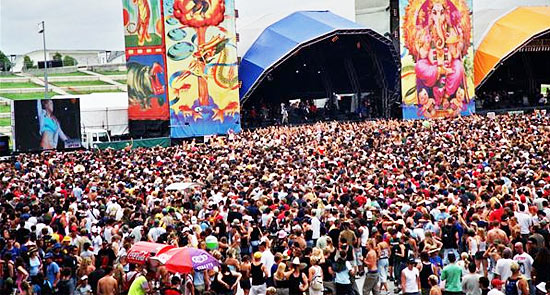
The Big Day Out is searching for a new venue for its northern leg.
The multi-state jamboree has long been one of the iconic events of the Australian summer, bringing some of the world’s biggest music stars to hundreds of thousands often delirious fans. But big festivals need big infrastructure, and the Big Day Out has been told by the Gold Coast City Council that its long-time venue at the Gold Coast Parklands will no longer be available. The Council and the Queensland Government are redeveloping the venue for the 2018 Commonwealth Games, and talks about a replacement venue at Helensvale have reportedly broken down.
The news quickly sparked interest from other municipalities in Queensland and northern New South Wales, eager for the tourist dollars they hope to bring their way. Mayors and local councillors from as far away as Cairns, Townsville and the Tweed have put up their hands to host the event, with the Tweed Shire Council apparently in the box seat.
Tweed Shire councillor Warren Polglase captured the ambition when he told the Tweed Daily News “we’ll work our backsides off to get it”: “It’d bring stimulus to traders. And visitations by thousands of people could lead to further opportunities in the shire.”
The attitude is not surprising. Big festivals can mean big money for local economics, particularly when the bulk of visitors are tourists from out of town. The punters arriving for events often spend up on local goods and services, such as accommodation, travel and food and drink. Festivals themselves are also big spenders, requiring forklifts, generators, portaloos, stage managers and a host of other event services in the run-up to the big day.
Festivals are getting much savvier at promoting their economic value. Just this week, for instance, Festivals Adelaide, the new industry group representing Adelaide’s 10 big cultural festivals, released an economic impact study claiming they brought $63 million and 790 jobs to the state.
But how seriously can we take such figures? The world of festivals and events is notorious for inflated attendance figures and dubious methodologies — perhaps most infamously in the case of the Australian Grand Prix; its rubbery figures have seen reported attendances grow, even as the event has cost the state of Victoria more to stage.
Australia’s best-credentialled academic researcher on festivals is Wollongong professor Chris Gibson. He’s just completed a major study of hundreds of regional festivals, funded by the Australian Research Council. He says we need to be wary of economic impact studies like Festivals Adelaide’s.
“You need to understand how festivals contribute to regional developmental in a qualitative sense, as well as a quantitative sense,” he told Crikey. “As soon as you pick apart the numbers, they become flimsy; you’re better off to understand qualitatively how a festival catalyses regional development. The festivals report from Adelaide uses those conventional methodologies, and there’s an orthodoxy now with festivals surveys; its very microeconomic in its methods.”
“I don’t think festivals should be judged on their economic impact; it’s not what they’re about, really.”
The findings of Gibson’s study of regional festivals may well surprise mayors looking to lure large events. It’s not the mega-festivals like the Big Day Out that make the biggest difference, he says, but rather a year-round ecology of smaller events.
“Some places that have done particularly well out of festivals have no festivals that are well-known,” he said, pointing to Ballarat which has more than 60 festivals each year, “hardly any of which are significant in commercial terms”. Instead, the regular parade of small events has created a vibrant events industry that caters to the year-round calendar.
“If you have that many small events run in a town that size, essentially what you have is a service industry, a well-oiled machine that operates locally to service those events. It’s the everyday interactions between accommodation providers, PA hire firms, portaloo hirers, that are sustained throughout the year, and the benefits of the festivals are managed and spread out across the calendar more effectively,” he said.
Gibson points out there is still “an old-school, masculinist view of regional development” which sees big infrastructure and big events as what matters.
Perhaps surprisingly, when it comes to the value of economic studies, Festivals Adelaide executive officer Tory McBride agrees. “Frankly, we do this because people love figures, but it’s a kind of a furphy,” she revealed to Crikey. “I don’t think festivals should be judged on their economic impact; it’s not what they’re about, really.”
“My feeling is that the social and cultural impact is far more important to a state or a city than its economic impact,” McBride said. “It’s entirely important that government bodies support cultural events in their cities, because that’s what makes them different — and great.”
After working in France for 20 years, McBride returned to South Australia to find some of the biggest performing arts events in the world were held there. “I’m an Adelaide person, born and educated here, and like most Adelaide people I went elsewhere when I was young, but I came back and I thought, ‘woah, Adelaide is happening now!'”
“The festivals are absolutely extraordinary. How is that this little city in the bottom right hand corner of the world has produced this enormous cultural vitality?”
McBride says this is the last year that Festivals Adelaide will measure the city’s events using only economic methodology — from 2013 on, the events will be evaluated using a much wider set of social and cultural measures. She points to research out of Edinburgh about its festivals. “They talk about the far-reaching impact on local and national life, particularly about the contributions to local and national identity and pride … this is qualitative research rather than quantitative,” she said.
The big question for the sector will be whether anyone is listening. Economic impact studies and quantitative research in the arts have been taken up by arts organisations desperate to justify their value to the bean-counters and the politicians. But in the United Kingdom, where such measures are far more widespread than here, all the fancy scorecards counted for nothing when the Cameron government launched its austerity drive, cutting arts funding savagely. Many in Britain are now wondering whether all the measurement and evaluation was worth it.








I’ve never understood why the Queensland big day out isn’t held in BrisVegas, and in particular, at the Brisbane show grounds.
Yes, why not have BDO in Brisbane RNA, at least you there is public transport, toilets etc, … The last time I went there was a typical storm at southport, and the traffic wardens, in their wisdom, decided that none of the twenty empty buses that would shuttle people to the railway, for the journey to Brisbane, were not to move for A WHOLE BLOODY HOUR…. A joke joke in organisation ,,, never again
Very interesting article. I’ve done some work in events research and inevitably the sponsoring governmental organization /event team wants an understanding of the economic impact of the event as a primary research outcome. Social and environmental outcomes are often only explored in a tokenistic manner if at all. always in the immediate, and never in the broader sense.
The ironic thing is that the far reaching impacts to national identity probably have an economic multiplier that far exceeds the initial impact of any one off event in terms of creating innovative environments, entrepreneurialism and future possibilities for activity. This is what really needs to be measured…
Economic benefits figures seem to have little relation to reality. In the case of locals attending the event, it is really a reallocation of expenditure, with net benefit zero. Interstate and international visitors do add economic benefit, but a really big event may reduce normal travellers. There is no evidence that extra planes come to Melbourne for the Grand Prix, and it can be assumed that the number of visitors specifically visiting for this event is small. At any given point in time there are probably 50-100,000 overseas visitors in Melbourne. Some may attend the GP, but this would not necessarily be the purpose of their visit. the Australian tennis open may attract visitors, but many are players, coaches etc who have their accommodation and other expenses paid by the organisers. Actually the tennis people don’t make silly claims about economic benefit, but I suspect that the open may be of far greater value than the grand Prix.
Chas and Mike Dwyer;
Much of the research and the media’s myopic attention is devoted to to sporting functions that are specifically designed for TV audiences that are broadcast throughout the world.
The commentators devote little or no attention to the arts specific events such as the forthcoming Perth Festival let alone the second biggest Fringe Festival in the world that is an annual Adelaide event. Ben didn’t even mention them last year.
The forthcoming Melbourne Comedy Festival has a worldwide reputation.
Not only do these festivals have a direct economic impact on their local communities but also create and showcase the enormous pool of local artistic talent that would otherwise have to seek work overseas.